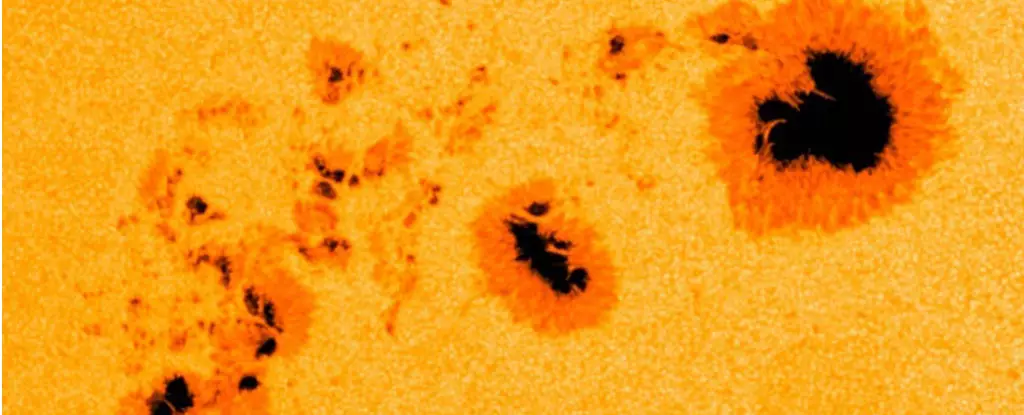The enigmatic relationship between the Sun and Earth has captivated human imagination since ancient civilizations first looked up at the sky. Revered as the ultimate source of light and warmth, the Sun underpins life on Earth, influencing not just the agricultural rhythms, but also the progression of scientific thought throughout history. The exploration of sunspots—a phenomenon that sparked both curiosity and caution—highlights the intricate dynamics of solar activity and its profound implications for our technological world.
From early civilizations to modern scientific inquiry, the Sun has been a focal point of intrigue. Ancient cultures created myths and celestial maps to understand its cyclical patterns. As humanity advanced, so did our tools for observing the heavens. The invention of the compass in ancient China, pivotal to navigation, marked the beginning of a quest to decode celestial orientations. In the late 16th century, figures like William Gilbert brought forth more comprehensive understandings of magnetism, proposing that Earth itself operates as a colossal magnet. This was foundational but only scratched the surface of solar phenomena’s complexities.
The 17th century ushered in a new era for solar observation. Galileo, with his groundbreaking telescope, was among the first to document sunspots—dark patches on the Sun’s surface that hinted at deeper mysteries. Despite his observations suggesting the Sun’s rotation and variations in sunspot size, Galileo failed to establish any connection between these dark regions and magnetic phenomena, leaving a gap in understanding that would not be filled for centuries.
A significant chapter in solar history is the Maunder Minimum, a period from 1645 to 1715 during which sunspots mysteriously vanished. This absence led to speculation and intrigue among astronomers, as this period aligned with a notably cold phase in Europe’s climate, now often referred to as the Little Ice Age. The reappearance of sunspots in 1715 rekindled fervor in solar studies, yet the underlying causes remained elusive for many years.
Astrophysicist George Ellery Hale emerged in the early 20th century, making pivotal contributions to our understanding of sunspot magnetism. His observations indicated that sunspots were not simply blemishes but rather regions of intense magnetic activity, capable of affecting solar dynamics profoundly. This revelation laid foundational theories for what is now recognized as the solar cycle—a recurring 11-year pattern of sunspot activity that influences not just the Sun but also Earth’s magnetic environment.
The 1859 Carrington Event marked a significant turning point in the study of solar activity. Richard Carrington, blending his work as an amateur astronomer with brewing fortune, witnessed an astonishing solar flare that coincided with widespread auroras and electrical disturbances on Earth. This event highlighted the Sun’s capacity to influence terrestrial phenomena profoundly. Telegram systems, the backbone of communication at the time, were disrupted, leading to increased awareness of the solar-terrestrial connection.
What makes the Carrington Event particularly striking is its enduring legacy in understanding solar flares and coronal mass ejections (CMEs). The explosive release of magnetic energy during such events can propel charged particles toward Earth, creating beautiful auroras but also posing risks to modern technology. Each cycle of solar activity impacts satellites, communication systems, and even power grids—illustrating how deeply intertwined our lives are with the Sun’s whims.
Today, we possess a far deeper understanding of the magnetism intrinsic to sunspots and their behavioral patterns. The solar-terrestrial relationship is no longer a domain of speculation; it is defined by empirical evidence and sophisticated modeling techniques. Scientists can now predict solar cycles with remarkable accuracy and monitor sunspot numbers regularly, which is vital for preparedness against potential disruptions.
With the current solar cycle nearing a peak, it becomes critical for both astrophysicists and technologists to remain vigilant. The potential for significant solar storms, akin to the Carrington Event, looms on the horizon. These events blend beauty with danger, as spectacular displays of auroras can be seen in unexpected locations while simultaneously threatening critical infrastructure.
The Sun, as a potent influencer of life on Earth and a remarkable subject of scientific inquiry, continues to evoke wonder and respect. Our understanding of sunspots navigates a journey from myth and speculation to sophisticated science. As we face unprecedented advances and vulnerabilities in technology, safeguarding against solar activity becomes essential. Through the lens of history, science, and the ever-watchful gaze of humanity, the relationship with our fiery neighbor remains a beacon of intrigue, illuminating our path into the future.


Leave a Reply